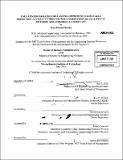Call center demand forecasting : improving sales calls prediction accuracy through the combination of statistical methods and judgmental forecast
Author(s)
Boulin, Juan Manuel
DownloadFull printable version (11.13Mb)
Other Contributors
Leaders for Global Operations Program.
Advisor
Roy E. Welsch and David Simchi-Levi.
Terms of use
Metadata
Show full item recordAbstract
Call centers are important for developing and maintaining healthy relationships with customers. At Dell, call centers are also at the core of the company's renowned direct model. For sales call centers in particular, the impact of proper operations is reflected not only in long-term relationships with customers, but directly on sales and revenue. Adequate staffing and proper scheduling are key factors for providing an acceptable service level to customers. In order to staff call centers appropriately to satisfy demand while minimizing operating expenses, an accurate forecast of this demand (sales calls) is required. During fiscal year 2009, inaccuracies in consumer sales call volume forecasts translated into approximately $1.1M in unnecessary overtime expenses and $34.5M in lost revenue for Dell. This work evaluates different forecasting techniques and proposes a comprehensive model to predict sales call volume based on the combination of ARIMA models and judgmental forecasting. The proposed methodology improves the accuracy of weekly forecasted call volume from 23% to 46% and of daily volume from 27% to 41%. Further improvements are easily achievable through the adjustment and projection processes introduced herein that rely on contextual information and the expertise of the forecasting team.
Description
Thesis (M.B.A.)--Massachusetts Institute of Technology, Sloan School of Management; and, (S.M.)--Massachusetts Institute of Technology, Engineering Systems Division; in conjunction with the Leaders for Global Operations Program at MIT, 2010. Cataloged from PDF version of thesis. Includes bibliographical references (p. 79-81).
Date issued
2010Department
Leaders for Global Operations Program at MIT; Massachusetts Institute of Technology. Engineering Systems Division; Sloan School of ManagementPublisher
Massachusetts Institute of Technology
Keywords
Sloan School of Management., Engineering Systems Division., Leaders for Global Operations Program.